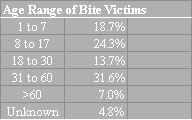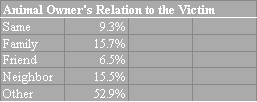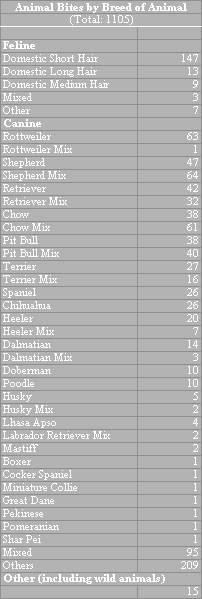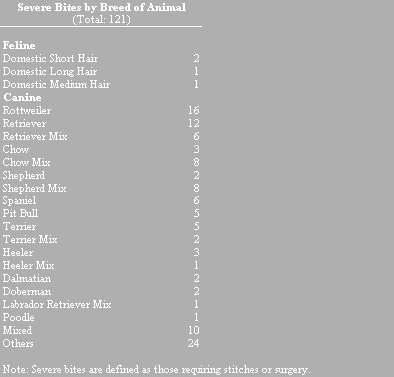|
The
Animal Care and Control Division of the City of Fort Worth
Public Health Department investigated 1,105 reported bite
incidents between July 1, 2000 and June 30, 2001. Injury ranged
in severity from minimal (26.3%) to requiring surgical treatment
(1.4%). Most bite injuries were treated with first aid (54.2%),
but 106 individuals (9.6%) required stitches. The majority of
injuries from animal bites involved the extremities including
the arms, legs and hands (72.5%), though 197 individuals (17.8%)
received bite injuries to the head and 83 (7.5%) received bite
injuries to the trunk.
Slightly
more bite victims were male (54.6%) than female (45.4%). Most
were between the ages of 31 and 60, though the next two largest
age groups were 8 to 17 and 1 to 7 years old. Over sixty percent
of bite victims were White, although Whites comprise only 45.8%
of the Fort Worth population. Other racial/ethnic groups were
represented proportionately or in lesser proportions compared to
the 2000 Fort Worth population1. Age adjustment will
be possible with the release of more detailed Census data later
in the year.
 

Almost
forty-percent (38.5%) of victims had at least a high school
education. More than 45% of bite victims were either the owner
or acquainted with the owner of the animal as either family,
friend or neighbor. However, in most cases (73.7%), the owner
was not present at the time of the incident. The majority of
victims (78.6%) did not provoke the animal. Of those individuals
who did, the most commonly cited situation was startling or
awaking an animal (8.9%).
Most
of the animals involved in bite incidents were dogs (82.4%).
Cats were indicated in 16.2% of cases and other animals were
cited in the remaining 1.4% of cases. Over twice as many male
animals were involved in bite cases as females, 51.3% and 22.1%
respectively, but animal gender was unknown for 26.6% of
reported cases. The age of animal was unknown for the majority
of bite incidents (63.3%). For those in which age was known, 32%
of animals were 6 or more years old. Owned animals were involved
in the majority of cases reported (75.3%), with stray and wild
animals accounting for the remaining 24.7%.
Nearly
ninety percent (89.2%) of animals involved in bite incidents
were not vaccinated against rabies and over ninety-five percent
(95.6%) were not licensed with the city. Domestic short haired
cats made up the majority of cats involved in bite incidents,
while Rottweilers, Shepherds, Retrievers, Chows, and Pit Bulls (as
well as mixes of these breeds) were among the top five breeds of
dog involved in bite incidents.

Analysis
of bite frequency by day of the week indicates that Saturdays
had the highest occurrence of animal bites (195), followed by
Tuesdays and Fridays with 180 and 162 bites respectively. The
graph of bite frequency by month shows an increase in animal
bites during the early spring months, peaking in April.
Severe
animal bites (resulting in either surgery or stitches) account
for 121 of the 1105 reported incidents (11%). The majority of
these victims (53.7%) were under 18 years of age and most were
male (61.2%). Proportionately, more Whites (66.9%) were the
victims of severe animal bites than Hispanics and African
Americans, 18.2% and 11.6% respectively. At the time of the
incident, the most commonly cited known activities of the victim
were playing (15.7%) and walking (10.7%). Other activities
identified by victims at the time of the incident included
petting and teasing, but the majority (66.1%) of respondents
reported engaging in "other" activities. Although the
majority of severe bite victims (63.6%) did not report provoking
the animal, over one third (36.4%) reported the animal was
provoked compared to 19.7% for victims of less serious bites.
The most common provocation cited was startling or awakening the
animal (13.6%). Though 52.9% of severe bites were sustained to
the extremities (hands, arms, legs), 40.5% of these incidents
involved a bite to the head.
Most
animals involved in severe bite incidents were dogs (96.7%). Of
the four cats implicated in severe incidents, three were strays.
Almost all of the dogs (94.9%) involved were owned. The two
breeds of dog indicated in the most severe bite incidents were
Rottweilers and Retrievers. The majority of animals involved in
severe bites were male (71.1%). Age of animal was unknown in the
majority of cases (52.9%). For the cases where age was known,
61.4% of animals were three years or younger. Again, a very high
percentage of animals involved in severe bites were not
vaccinated against rabies (84.3%) nor were they licensed with
the city (95%).

Information
regarding the animal owners is limited due to the owner’s
reluctance to participate in the survey activity. However, where
gender is known, owners of animals involved in severe bites are
almost equally divided between the genders with males accounting
for 51.7% of animal owners. Gender was unknown in 50.4% of the
cases. Similarly, age was unknown in 58.6% of the cases. In
cases where age is known, the majority (74%) of owners were
between the ages of 31 and 60. Educational attainment is known
in 52% of cases. Owners having completed high school and those
completing college each account for 25.4% of the sample, while
4.8% report a grade school education and 44.4% of the sample
report "other" educational experience.
Bite
incidents were geocoded for use in a geographic information
system. Initial geocoding was accomplished utilizing a street
file that covers all of Tarrant County since the Animal Control
service area extends outside of the city borders. Addresses that
were not matched in this file were geocoded against an updated
map of streets in the City of Fort Worth. Of the 1105 reported
bite incidents, twenty-two addresses could not be mapped. This
accounts for only 2% of bite cases.
Thematic
mapping of bite frequency by different geographic strata
indicates a higher concentration of incidents in the areas
immediately south and northwest of the central city in the
76106, 76110, 76119, and 76133 ZIP codes. The second highest
frequency stratum of bite incidents contains six ZIP codes:
76105, 76107, 76111, 76112, 76116, and 76137. This is largely
consistent with results from the first nine months of the
project. Thematic mapping of bites rates calculated by Census
tract using 2000 population figures reveals a similar pattern as
seen when frequency of bites is mapped by ZIP code. Two of the
three high bite rate tracts are within the boundaries of the
76107 and 76119 ZIP codes. Both of these are among the top two
strata of ZIP code areas by bite frequency. The third tract
identified with a high rate of bites lies mainly within the
76104 ZIP code boundary, though seven of the eight bites
reported in this tract are within the 76103 boundary. All of
these bites occurred along East Lancaster Avenue and four were
reported from the same address. Upon further investigation, this
address was found to be that of the Humane Society of North
Texas.
Spatial
analyses to determine the distributions of more detailed
characteristics of bite incidents is ongoing. Maps of bite
distributions in two ZIP code areas from the highest frequency
stratum (76110 and 76119) have been utilized in the planning of
educational interventions targeting potential victims and animal
owners. Analyses of bites by species and confinement status have
directed the deployment of media resources to address the bite
prevention education needs of the area. Post-intervention
evaluation of animal bite distribution will be conducted to
assess the effectiveness of the program.
Mapping
of animal bite incidents has proven useful in presenting data to
different segments of the population. Neighborhood associations
who have historically been resistant to join in collaborative
efforts have supported intervention activities as a result of
the visual representation of bite occurrences. Additionally, the
local news media has publicized and promotes the project based
on the compelling nature of maps displaying the distribution of
bites in the community. The capacity to represent spatial data
in the medium of a map has proven itself an invaluable tool in
visualizing data and making results understandable to the
general public.
________________________
1 U.S.
Census Bureau, Census 2000 Redistricting Data Summary File.
|

